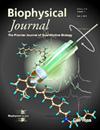Low pH amplifies chemotaxis toward urea in Helicobacter pylori.
IF 3.2
3区 生物学
Q2 BIOPHYSICS
引用次数: 0
Abstract
Helicobacter pylori infections increase the risk of non-cardia gastric adenocarcinoma, and chemotaxis toward metabolites such as urea plays a key role in modulating infection. Chemotaxis studies are more insightful in strains of H. pylori that are amenable to genetic modification, such as the G27 strain. However, motility in G27 cells can be inconsistent and varies with growth conditions, raising questions about its chemotaxis abilities. Here, we quantitatively compared motility and urea chemotaxis between the G27 strain and the highly motile PMSS1 strain. We observed that G27 cells swim ∼ 40% slower than the PMSS1 cells, likely because the former possessed one flagellum on average, whereas the latter had multiple flagella. Despite its slow swimming, G27 exhibited a strong chemotactic response to urea with optimal output under physiological temperature (37°C). Significantly, low pH conditions amplified the urea response, and comparisons of the experiments with a mathematical model suggested that low pH increases chemoreceptor sensitivity toward the metabolite. These results are consistent with the possibility that the harsh acidic environment of the stomach enhances migration toward urea, which the cells degrade to neutralize the local pH and facilitate their survival.低pH值放大幽门螺杆菌对尿素的趋化性。
幽门螺杆菌感染增加非贲门性胃腺癌的风险,对代谢产物如尿素的趋化作用在调节感染中起关键作用。趋化性研究在可接受基因改造的幽门螺杆菌菌株(如G27菌株)中更有见地。然而,G27细胞的运动性可能不一致,并随着生长条件的变化而变化,这引起了对其趋化能力的质疑。在这里,我们定量比较了G27菌株和高运动性PMSS1菌株的运动性和尿素趋化性。我们观察到G27细胞的游动速度比PMSS1细胞慢约40%,这可能是因为前者平均只有一个鞭毛,而后者有多个鞭毛。尽管游得慢,但G27对尿素表现出强烈的趋化反应,在生理温度(37℃)下产量最佳。值得注意的是,低pH条件放大了尿素反应,与数学模型的实验比较表明,低pH增加了化学受体对代谢物的敏感性。这些结果与胃的恶劣酸性环境增强向尿素迁移的可能性一致,细胞降解尿素以中和局部pH值并促进其生存。
本文章由计算机程序翻译,如有差异,请以英文原文为准。
求助全文
约1分钟内获得全文
求助全文
来源期刊

Biophysical journal
生物-生物物理
CiteScore
6.10
自引率
5.90%
发文量
3090
审稿时长
2 months
期刊介绍:
BJ publishes original articles, letters, and perspectives on important problems in modern biophysics. The papers should be written so as to be of interest to a broad community of biophysicists. BJ welcomes experimental studies that employ quantitative physical approaches for the study of biological systems, including or spanning scales from molecule to whole organism. Experimental studies of a purely descriptive or phenomenological nature, with no theoretical or mechanistic underpinning, are not appropriate for publication in BJ. Theoretical studies should offer new insights into the understanding ofexperimental results or suggest new experimentally testable hypotheses. Articles reporting significant methodological or technological advances, which have potential to open new areas of biophysical investigation, are also suitable for publication in BJ. Papers describing improvements in accuracy or speed of existing methods or extra detail within methods described previously are not suitable for BJ.
 求助内容:
求助内容: 应助结果提醒方式:
应助结果提醒方式:


